Mangal Shobhajatra
| Mangal Shobhajatra মঙ্গল শোভাযাত্রা | |
|---|---|
 Mangal Shobhajatra (2015) | |
| Status | Active |
| Genre | Procession |
| Date(s) | 14 April |
| Frequency | Annually |
| Location(s) | Dhaka University campus |
| Coordinates | 23°44′00″N 90°23′27″E / 23.733242°N 90.3909218°ECoordinates: 23°44′00″N 90°23′27″E / 23.733242°N 90.3909218°E |
| Country | Bangladesh |
| Years active | 1989 - present |
| Organised by | Dhaka University Faculty of Fine Arts |
Mangal Shobhajatra or Mangal Shovajatra (Bengali: মঙ্গল শোভাযাত্রা) is a mass procession arranged at the dawn of the first day of Bengali New Year in Bangladesh.[1] The procession is organised by the teachers and students of the Faculty of Fine Arts of the Dhaka University.[2] The festival is considered as a secular identity of the Bangladeshi people as it unites the people irrespective of caste, creed, religion, gender or age.[3] It is one of the Intangible Cultural Heritages declared by UNESCO,[4] categorised on the representative list as a heritage of humanity.[5][6]
Etymology
Mangal Shobhajatra literally means "procession for well-being".[7]
History and about

The procession of the festival was first observed in 1989, when the autocratic ruler Hussain Muhammad Ershad was the president of the country. At that time, the country was devastated by floods and imposition of military rule, putting the general people in great distress. The students of Dhaka University Faculty of Fine Arts decided to fight against the military regime in a creative and festive way.[8][9] Since then, the students and teachers of the faculty have remained in the forefront for organising the rally.[10]
Thousands of people take part in the procession that features life-sized replicas of bird, fish, animals, and other motifs. The rally symbolises strength, peace and a driving away of evil to allow for progress.[6][5] It is considered as a secular identity of the people uniting the people irrespective of caste, creed, religion, gender or age.[3]
UNESCO recognition
In 2014, a nomination file on the festival was submitted by the Bangla Academy, approved by the Ministry of Cultural Affairs of Bangladesh was submitted to UNESCO.[8] On 30 November 2016, the festive was selected as an Intangible Cultural Heritage by UNESCO at the 11th session of the Inter-governmental Committee on Safeguarding Intangible Cultural Heritage held in Addis Ababa, Ethiopia.[11] The committee noted that "the rally symbolises the pride of the people of Bangladesh in their living heritage as well as their strength and courage to fight sinister forces, and their vindication of truth and justice."[12]
References
- ↑ Habib, Haroon. "Dramatic dawn". The Hindu. Retrieved 2016-11-30.
- ↑ "'Mangal Shobhajatra' for removing evil". bdnews24.com. Retrieved 2016-11-30.
- 1 2 "La bière belge inscrite au "patrimoine culturel immatériel" de l'humanité par l'Unesco". Le Huffington Post. Retrieved 2016-11-30.
- ↑ "UNESCO recognises Mangal Shobhajatra as cultural heritage". UNESCO official site. 2016-11-30. Retrieved 2016-11-30.
- 1 2 "UNESCO recognises Mangal Shobhajatra as cultural heritage". The Daily Star. 2016-11-30. Retrieved 2016-11-30.
- 1 2 "UNESCO lists Mangal Shobhajatra as cultural heritage". Prothom Alo. Retrieved 2016-11-30.
- ↑ "Mangal Shobhajatra included in Unesco cultural heritage list - The Nation". The Nation. Retrieved 2016-12-01.
- 1 2 "Unesco lists Mangal Shobhajatra as cultural heritage". The Daily Star. 2016-12-01. Retrieved 2016-12-01.
- ↑ "Pohela Boishakh's rally gets UNESCO's recognition". Prothom Alo. Retrieved 2016-12-01.
- ↑ "Mangal Shobhajatra gets recognition as cultural heritage | Business News 24 BD". businessnews24bd.com. Retrieved 2016-12-01.
- ↑ "Mangal Shobhajatra gets recognition as cultural heritage | Business News 24 BD". businessnews24bd.com. Retrieved 2016-11-30.
- ↑ "Unesco lists Mangal Shobhajatra as cultural heritage". The Daily Star. 2016-12-01. Retrieved 2016-12-01.
External links
| Wikimedia Commons has media related to Mangal Shobhajatra. |
- "Mangal Shobhajatra on Pahela Baishakh". UNESCO. 28 November 2016. Retrieved 30 November 2016.